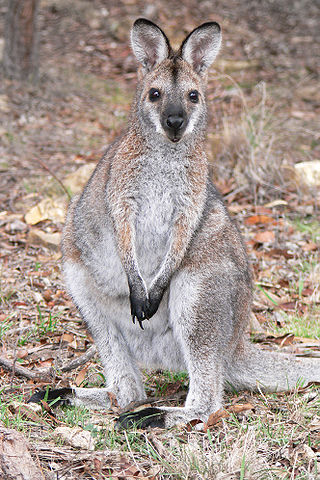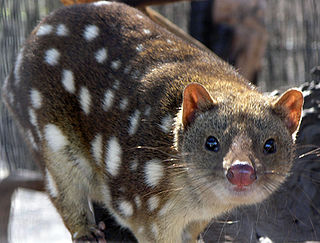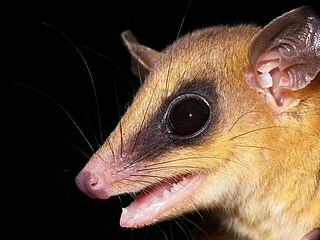Subclass Theria
Infraclass Metatheria (marsupials)
Order Didelphimorphia (American opossums)
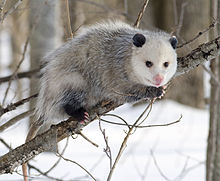
- Family Didelphidae (opossums)
- Subfamily Caluromyinae
- Genus Caluromysiops
- Black-shouldered opossum (Caluromysiops irrupta)
- Genus Caluromys (woolly opossum)
- Subgenus Caluromys
- Bare-tailed woolly opossum (Caluromys philander)
- Subgenus Mallodelphys
- Derby's woolly opossum (Caluromys derbianus)
- Brown-eared woolly opossum (Caluromys lanatus)
- Subgenus Caluromys
- Genus Caluromysiops
- Subfamily Glironiinae
- Genus Glironia
- Bushy-tailed opossum (Glironia venusta)
- Genus Glironia
- Subfamily Hyladelphinae
- Genus Hyladelphys
- Kalinowski's mouse opossum (Hyladelphys kalinowskii)
- Genus Hyladelphys
- Subfamily Didelphinae
- Tribe Metachirini
- Genus Metachirus
- Brown four-eyed opossum (Metachirus myosuros)
- Genus Metachirus
- Tribe Didelphini
- Genus Chironectes
- Yapok or water opossum (Chironectes minimus)
- Genus Lutreolina
- Massoia's lutrine opossum (Lutreolina massoia)
- Big lutrine opossum or thick-tailed opossum (Lutreolina crassicaudata)
- Genus Philander (gray and black four-eyed opossum)
- Anderson's four-eyed opossum (Philander andersoni)
- Deltaic four-eyed opossum (Philander deltae)
- Southeastern four-eyed opossum (Philander frenatus)
- McIlhenny's four-eyed opossum (Philander mcilhennyi)
- Mondolfi's four-eyed opossum (Philander mondolfii)
- Olrog's four-eyed opossum (Philander olrogi)
- Gray four-eyed opossum (Philander opossum)
- Genus Didelphis
- White-eared opossum (Didelphis albiventris)
- Big-eared opossum (Didelphis aurita)
- Guianan white-eared opossum (Didelphis imperfecta)
- Common opossum (Didelphis marsupialis)
- Andean white-eared opossum (Didelphis pernigra)
- Virginia opossum (Didelphis virginiana)
- Genus Chironectes
- Tribe Thylamyini
- Genus Chacodelphys
- Chacoan pygmy opossum (Chacodelphys formosa)
- Genus Cryptonanus
- Agricola's gracile opossum (Cryptonanus agricolai)
- Chacoan gracile opossum (Cryptonanus chacoensis)
- Guahiba gracile opossum (Cryptonanus guahybae)
- †Red-bellied gracile opossum (Cryptonanus ignitus)
- Unduavi gracile opossum (Cryptonanus unduaviensis)
- Genus Gracilinanus
- Aceramarca gracile opossum (Gracilinanus aceramarcae)
- Agile gracile opossum (Gracilinanus agilis)
- Wood sprite gracile opossum (Gracilinanus dryas)
- Emilia's gracile opossum (Gracilinanus emilae)
- Northern gracile opossum (Gracilinanus marica)
- Brazilian gracile opossum (Gracilinanus microtarsus)
- Genus Lestodelphys
- Patagonian opossum (Lestodelphys halli)
- Genus Marmosops (slender opossum)
- Bishop's slender opossum (Marmosops bishopi)
- Narrow-headed slender opossum (Marmosops cracens)
- Creighton's slender opossum (Marmosops creightoni)
- Dorothy's slender opossum (Marmosops dorothea)
- Dusky slender opossum (Marmosops fuscatus)
- Handley's slender opossum (Marmosops handleyi)
- Tschudi's slender opossum (Marmosops impavidus)
- Gray slender opossum (Marmosops incanus)
- Panama slender opossum (Marmosops invictus)
- Junin slender opossum (Marmosops juninensis)
- Neblina slender opossum (Marmosops neblina)
- White-bellied slender opossum (Marmosops noctivagus)
- Little spotted slender opossum (Marmosops ocellatus)
- Delicate slender opossum (Marmosops parvidens)
- Brazilian slender opossum (Marmosops paulensis)
- Pinheiro's slender opossum (Marmosops pinheiroi)
- Genus Thylamys (fat-tailed mouse opossum)
- Cinderella fat-tailed mouse opossum (Thylamys cinderella)
- Elegant fat-tailed mouse opossum (Thylamys elegans)
- Karimi's fat-tailed mouse opossum (Thylamys karimii)
- Paraguayan fat-tailed mouse opossum (Thylamys macrurus)
- White-bellied fat-tailed mouse opossum (Thylamys pallidior)
- Common fat-tailed mouse opossum (Thylamys pusillus)
- Argentine fat-tailed mouse opossum (Thylamys sponsorius)
- Tate's fat-tailed mouse opossum (Thylamys tatei)
- Dwarf fat-tailed mouse opossum (Thylamys velutinus)
- Buff-bellied fat-tailed mouse opossum (Thylamys venustus)
- Genus Chacodelphys
- Tribe Marmosini
- Genus Tlacuatzin
- Gray mouse opossum (Tlacuatzin canescens)
- Genus Marmosa (mouse opossum)
- Subgenus Stegomarmosa
- Heavy-browed mouse opossum (Marmosa andersoni)
- Subgenus Marmosa
- Isthmian mouse opossum (Marmosa isthmica)
- Rufous mouse opossum (Marmosa lepida)
- Mexican mouse opossum (Marmosa mexicana)
- Linnaeus's mouse opossum (Marmosa murina)
- Quechuan mouse opossum (Marmosa quichua)
- Robinson's mouse opossum (Marmosa robinsoni)
- Red mouse opossum (Marmosa rubra)
- Tyler's mouse opossum (Marmosa tyleriana)
- Guajira mouse opossum (Marmosa xerophila)
- Subgenus Micoureus
- Alston's mouse opossum (Marmosa alstoni)
- White-bellied woolly mouse opossum (Marmosa constantiae)
- Tate's woolly mouse opossum (Marmosa paraguayanus)
- Little woolly mouse opossum (Marmosa phaeus)
- Woolly mouse opossum (Marmosa demerarae)
- Bare-tailed woolly mouse opossum (Marmosa regina)
- Subgenus Stegomarmosa
- Genus Monodelphis (short-tailed opossum)
- Subgenus Minuania
- Ronald's opossum (Monodelphis ronaldi)
- Chestnut-striped opossum (Monodelphis rubida)
- Reig's opossum (Monodelphis reigi)
- Long-nosed short-tailed opossum (Monodelphis scalops)
- Yellow-sided opossum (Monodelphis dimidiata)
- Red three-striped opossum (Monodelphis umbristriata)
- Subgenus Monodelphis
- Sepia short-tailed opossum (Monodelphis adusta)
- Amazonas short-tailed opossum (Monodelphis amazonica)
- Northern three-striped opossum (Monodelphis americana)
- Arlindo's opossum (Monodelphis arlindoi)
- Northern red-sided opossum (Monodelphis brevicaudata)
- Gray short-tailed opossum (Monodelphis domestica)
- Emilia's short-tailed opossum (Monodelphis emiliae)
- Gardner's short-tailed opossum (Monodelphis gardneri)
- Amazonian red-sided opossum (Monodelphis glirina)
- Handley's short-tailed opossum (Monodelphis handleyi)
- Ihering's three-striped opossum (Monodelphis iheringi)
- Pygmy short-tailed opossum (Monodelphis kunsi)
- (Monodelphis macae)
- Marajó short-tailed opossum (Monodelphis maraxina)
- Obscure short-tailed opossum (Monodelphis obscura)
- Osgood's short-tailed opossum (Monodelphis osgoodi)
- Hooded red-sided opossum (Monodelphis palliolata)
- (Monodelphis pinocchio)
- Santa Rosa opossum (Monodelphis sanctaerosae)
- Southern red-sided opossum (Monodelphis sorex)
- Southern three-striped opossum (Monodelphis theresa)
- One-striped opossum (Monodelphis unistriata)
- Subgenus Minuania
- Genus Tlacuatzin
- Tribe Metachirini
- Subfamily Caluromyinae
Order Paucituberculata
- Family Caenolestidae (shrew opossum)
- Genus Lestoros
- Incan caenolestid, (Lestoros inca)
- Genus Rhyncholestes
- Long-nosed caenolestid, (Rhyncholestes raphanurus)
- Genus Caenolestes
- Gray-bellied caenolestid, (Caenolestes caniventer)
- Andean caenolestid, (Caenolestes condorensis)
- Northern caenolestid, (Caenolestes convelatus)
- Dusky caenolestid, (Caenolestes fuliginosus)
- Genus Lestoros
Order Microbiotheria (monito del monte)
- Family Microbiotheriidae
- Genus Dromiciops
- Monito del monte (Dromiciops gliroides)
- Genus Dromiciops
Order Notoryctemorphia (marsupial moles)
- Family Notoryctidae
- Genus Notoryctes
- Northern marsupial mole (Notoryctes caurinus)
- Southern marsupial mole (Notoryctes typhlops)
- Genus Notoryctes
Order Dasyuromorphia (marsupial carnivores)
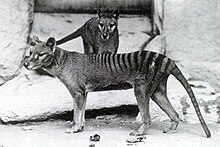
- Family †Thylacinidae
- Genus † Thylacinus
- †Thylacine (Thylacinus cynocephalus)
- Genus † Thylacinus
- Family Myrmecobiidae
- Genus Myrmecobius
- Numbat (Myremecobius fasciatus)
- Genus Myrmecobius
- Family Dasyuridae
- Subfamily Dasyurinae
- Tribe Dasyurini
- Genus Dasycercus (mulgaras)
- Crest-tailed mulgara, (Dasycercus cristicauda)
- Genus Dasykaluta
- Little red kaluta, (Dasykalua rosamondae)
- Genus Dasyuroides
- Kowari, (Dasyuroides byrnei)
- Genus Dasyurus (quolls)
- Subgenus Satanellus
- Northern quoll, (Dasyurus hallucatus)
- Subgenus Dasyurops
- Tiger quoll, (Dasyurus maculatus)
- Subgenus Dasyurinus
- Western quoll, (Dasyurus geoffroii)
- Subgenus Dasyurus
- New Guinean quoll, (Dasyurus albopunctatus)
- Bronze quoll, (Dasyurus spartacus)
- Eastern quoll, (Dasyurus viverrinus)
- Subgenus Satanellus
- Genus Myoictis
- Woolley's three-striped dasyure (Myoictis leucera)
- Three-striped dasyure, (Myoictis melas)
- Wallace's dasyure, (Myoictis wallacii)
- Tate's three-striped dasyure (Myoictis wavicus)
- Genus Neophascogale
- Speckled dasyure, (Neophascogale lorentzi)
- Genus Parantechinus
- Dibbler, (Parantechinus apicalis)
- Genus Phascolosorex
- Red-bellied marsupial shrew, (Phascolosorex doriae)
- Narrow-striped marsupial shrew, (Phascolosorex dorsalis)
- Genus Pseudantechinus
- Sandstone dibbler, (Pseudantechinus bilarni)
- Fat-tailed false antechinus, (Pseudantechinus macdonnellensis)
- Alexandria false antechinus, (Pseudantechinus mimulus)
- Ningbing false antechinus, (Pseudantechinus ningbing)
- Rory Cooper's false antechinus, (Pseudantechinus roryi)
- Woolley's false antechinus, (Pseudantechinus woolleyae)
- Genus Sarcophilus
- Tasmanian devil, (Sarcophilus harrisii)
- Genus Dasycercus (mulgaras)
- Tribe Phascogalini
- Genus Antechinus
- Tropical antechinus, (Antechinus adustus)
- Agile antechinus, (Antechinus agilis)
- Silver-headed antechinus, (Antechinus argentus)
- Black-tailed antechinus, (Antechinus arktos)
- Fawn antechinus, (Antechinus bellus)
- Yellow-footed antechinus, (Antechinus flaviceps)
- Atherton antechinus, (Antechinus godmani)
- Cinnamon antechinus, (Antechinus leo)
- Swamp antechinus, (Antechinus minimus)
- Buff-footed antechinus, (Antechinus mysticus)
- Brown antechinus, (Antechinus stuartii)
- Subtropical antechinus, (Antechinus subtropicus)
- Dusky antechinus, (Antechinus swainsonii)
- Tasman Peninsula Dusky antechinus, (Antechinus vandycki)
- Genus Murexia
- Subgenus Micromurexia
- Habbema dasyure, (Murexia habbema)
- Subgenus Murexechinus
- Lesser antechinus, (Murexia wilhelmina)
- Black-tailed dasyure, (Murexia melanurus)
- Subgenus Murexia
- Short-furred dasyure, (Murexia longicaudata)
- Subgenus Paramurexia
- Broad-striped dasyure, (Murexia rothschildi)
- Subgenus Phascomurexia
- Long-nosed dasyure, (Murexia naso)
- Subgenus Micromurexia
- Genus Phascogale
- Red-tailed phascogale, (Phascogale calura)
- Brush-tailed phascogale, (Phascogale tapoatafa)
- Genus Antechinus
- Tribe Dasyurini
- Subfamily Sminthopsinae
- Genus Sminthopsis
- Subgenus Antechinomys
- Kultarr, (Antechinomys laniger)
- Subgenus Ningaui
- Wongai ningaui, (Ningaui ridei)
- Pilbara ningaui, (Ningaui timealeyi)
- Southern ningaui, (Ningaui yvonneae)
- Subgenus Sminthopsis
- S. crassicaudata species-group
- Fat-tailed dunnart, (Sminthopsis crassicaudata)
- S. macroura species-group
- Kakadu dunnart, (Sminthopsis bindi)
- Carpentarian dunnart, (Sminthopsis butleri)
- Julia Creek dunnart, (Sminthopsis douglasi)
- Stripe-faced dunnart, (Sminthopsis macroura)
- Red-cheeked dunnart, (Sminthopsis virginiae)
- S. granulipes species-group
- White-tailed dunnart, (Sminthopsis granulipes)
- S. griseoventer species-group
- Kangaroo Island dunnart, (Sminthopsis aitkeni)
- Boullanger Island dunnart, (Sminthopsis boullangerensis)
- Grey-bellied dunnart, (Sminthopsis griseoventer)
- S. longicaudata species-group
- Long-tailed dunnart, (Sminthopsis longicaudata)
- S. murina species-group
- Chestnut dunnart, (Sminthopsis archeri)
- Little long-tailed dunnart, (Sminthopsis dolichura)
- Sooty dunnart, (Sminthopsis fuliginosus)
- Gilbert's dunnart, (Sminthopsis gilberti)
- White-footed dunnart, (Sminthopsis leucopus)
- Slender-tailed dunnart, (Sminthopsis murina)
- S. psammophila species-group
- Hairy-footed dunnart, (Sminthopsis hirtipes)
- Ooldea dunnart, (Sminthopsis ooldea)
- Sandhill dunnart, (Sminthopsis psammophila)
- Lesser hairy-footed dunnart, (Sminthopsis youngsoni)
- S. crassicaudata species-group
- Subgenus Antechinomys
- Genus Planigale
- Paucident planigale, (Planigale gilesi)
- Long-tailed planigale, (Planigale ingrami)
- Common planigale, (Planigale maculata)
- New Guinean planigale, (Planigale novaeguineae)
- Narrow-nosed planigale, (Planigale tenuirostris)
- Genus Sminthopsis
- Subfamily Dasyurinae
Order Peramelemorphia (bandicoots and bilbies)

- Family Thylacomyidae
- Genus Macrotis (bilbies)
- Greater bilby (Macrotis lagotis)
- †Lesser bilby (Macrotis leucura)
- Genus Macrotis (bilbies)
- Family Peramelidae
- Genus Isoodon : short-nosed bandicoots
- Golden bandicoot, (Isoodon auratus)
- Northern brown bandicoot, (Isoodon macrourus)
- Southern brown bandicoot, (Isoodon obesulus)
- Genus Perameles : long-nosed bandicoots
- Western barred bandicoot, (Perameles bougainville)
- Eastern barred bandicoot, (Perameles gunnii)
- Long-nosed bandicoot, (Perameles nasuta)
- †Desert bandicoot, (Perameles eremiana)
- Genus Isoodon : short-nosed bandicoots
- Family †Chaeropodidae
- Genus † Chaeropus (pig-footed bandicoots)
- †Southern pig-footed bandicoot (Chaeropus ecaudatus)
- †Northern pig-footed bandicoot (Chaeropus yirratji)
- Genus † Chaeropus (pig-footed bandicoots)
- Family Peroryctidae (New Guinean bandicoots)
- Subfamily Peroryctinae
- Genus Peroryctes : New Guinean long-nosed bandicoots
- Giant bandicoot, (Peroryctes broadbenti)
- Raffray's bandicoot, (Peroryctes raffrayana)
- Genus Peroryctes : New Guinean long-nosed bandicoots
- Subfamily Echymiperinae
- Genus Echymipera : New Guinean spiny bandicoots
- Long-nosed spiny bandicoot, (Echymipera rufescens)
- Clara's spiny bandicoot, (Echymipera clara)
- Menzies' spiny bandicoot, (Echymipera echinista)
- Common spiny bandicoot, (Echymipera kalubu)
- David's spiny bandicoot, (Echymipera davidi)
- Genus Microperoryctes : New Guinean mouse bandicoots
- Papuan bandicoot, (Microperoryctes papuensis)
- Subgenus Microperoryctes
- Mouse bandicoot, (Microperoryctes murina)
- Subgenus Ornoryctes
- Eastern striped bandicoot, (Microperoryctes ornata)
- Western striped bandicoot, (Microperoryctes longicauda)
- Arfak pygmy bandicoot, (Microperoryctes aplini)
- Genus Rhynchomeles
- Seram bandicoot, (Rhynchomeles prattorum)
- Genus Echymipera : New Guinean spiny bandicoots
- Subfamily Peroryctinae
Order Diprotodontia (diprotodont marsupials)
Suborder Vombatiformes (wombats and koalas)
- Family Phascolarctidae (koala)
- Genus Phascolarctos
- Koala (Phascolarctos cinereus)
- Genus Phascolarctos
- Family Vombatidae (wombats)
- Genus Lasiorhinus (hairy-nosed wombats)
- Northern hairy-nosed wombat (Lasiorhinus krefftii)
- Southern hairy-nosed wombat (Lasiorhinus latifrons)
- Genus Vombatus (naked-nosed wombat)
- Common wombat (Vombatus ursinus)
- Genus Lasiorhinus (hairy-nosed wombats)
Suborder Phalangeriformes (possums and gliders)
- Superfamily Phalangeroidea
- Family Burramyidae: pygmy possums
- Genus Burramys
- Mountain pygmy possum (Burramys parvus)
- Genus Cercartetus
- Long-tailed pygmy possum (Cercartetus caudatus)
- Southwestern pygmy possum (Cercartetus concinnus)
- Tasmanian pygmy possum (Cercartetus lepidus)
- Eastern pygmy possum (Cercartetus nanus)
- Genus Burramys
- Family Phalangeridae: brushtail possums and cuscuses
- Subfamily Trichosurinae
- Genus Trichosurus
- Northern brushtail possum (Trichosurus arnhemensis)
- Short-eared possum (Trichosurus caninus)
- Mountain brushtail possum (Trichosurus cunninghami)
- Coppery brushtail possum (Trichosurus johnstonii)
- Common brushtail possum (Trichosurus vulpecula)
- Genus Wyulda
- Scaly-tailed possum (Wyulda squamicaudata)
- Genus Trichosurus
- Subfamily Ailuropinae
- Genus Ailurops
- Talaud bear cuscus (Ailurops melanotis)
- Sulawesi bear cuscus (Ailurops ursinus)
- Genus Strigocuscus
- Sulawesi dwarf cuscus (Strigocuscus celebensis)
- Banggai cuscus (Strigocuscus pelegensis)
- Genus Ailurops
- Subfamily Phalangerinae
- Genus Phalanger
- Gebe cuscus (Phalanger alexandrae)
- Mountain cuscus (Phalanger carmelitae)
- Ground cuscus (Phalanger gymnotis)
- Eastern common cuscus (Phalanger intercastellanus)
- Woodlark cuscus (Phalanger lullulae)
- Blue-eyed cuscus (Phalanger matabiru)
- Telefomin cuscus (Phalanger matanim)
- Southern common cuscus (Phalanger mimicus)
- Northern common cuscus (Phalanger orientalis)
- Ornate cuscus (Phalanger ornatus)
- Rothschild's cuscus (Phalanger rothschildi)
- Silky cuscus (Phalanger sericeus)
- Stein's cuscus (Phalanger vestitus)
- Genus Spilocuscus
- Admiralty Island cuscus (Spilocuscus kraemeri)
- Common spotted cuscus (Spilocuscus maculatus)
- Waigeou cuscus (Spilocuscus papuensis)
- Black-spotted cuscus (Spilocuscus rufoniger)
- Blue-eyed spotted cuscus (Spilocuscus wilsoni)
- Genus Phalanger
- Subfamily Trichosurinae
- Family Burramyidae: pygmy possums
- Superfamily Petauroidea
- Family Pseudocheiridae
- Subfamily Hemibelideinae
- Genus Hemibelideus
- Lemur-like ringtail possum (Hemibelideus lemuroides)
- Genus Petauroides
- †New Guinea greater glider (Petauroides ayamaruensis)
- Southern greater glider (Petauroides volans)
- Northern greater glider (Petauroides minor)
- Central greater glider (Petauroides armillatus)
- Genus Hemibelideus
- Subfamily Pseudocheirinae
- Genus Petropseudes
- Rock-haunting ringtail possum (Petropseudes dahli)
- Genus Pseudocheirus
- Western ringtail possum (Pseudocheirus occidentalis)
- Common ringtail possum (Pseudocheirus peregrinus)
- Genus Pseudochirulus
- Lowland ringtail possum (Pseudochirulus canescens)
- Weyland ringtail possum (Pseudochirulus caroli)
- Cinereus ringtail possum (Pseudochirulus cinereus)
- Painted ringtail possum (Pseudochirulus forbesi)
- Herbert River ringtail possum (Pseudochirulus herbertensis)
- Masked ringtail possum (Pseudochirulus larvatus)
- Pygmy ringtail possum (Pseudochirulus mayeri)
- Vogelkop ringtail possum (Pseudochirulus schlegeli)
- Genus Petropseudes
- Subfamily Pseudochiropsinae
- Genus Pseudochirops
- D'Albertis' ringtail possum (Pseudochirops albertisii)
- Green ringtail possum (Pseudochirops archeri)
- Plush-coated ringtail possum (Pseudochirops corinnae)
- Reclusive ringtail possum (Pseudochirops coronatus)
- Coppery ringtail possum (Pseudochirops cupreus)
- Genus Pseudochirops
- Subfamily Hemibelideinae
- Family Petauridae
- Subfamily Dactylopsilinae
- Genus Dactylopsila
- Subgenus Dactylonax
- Long-fingered triok (Dactylopsila palpator)
- Subgenus Dactylopsila
- (Dactylopsila kambuayai)
- Great-tailed triok (Dactylopsila megalura)
- Tate's triok (Dactylopsila tatei)
- Striped possum (Dactylopsila trivirgata)
- Subgenus Dactylonax
- Genus Gymnobelideus
- Leadbeater's possum (Gymnobelideus leadbeateri)
- Genus Dactylopsila
- Subfamily Petaurinae
- Genus Petaurus
- Northern glider (Petaurus abidi)
- Yellow-bellied glider (Petaurus australis)
- Biak glider (Petaurus biacensis)
- Sugar glider (Petaurus breviceps)
- Mahogany glider (Petaurus gracilis)
- Squirrel glider (Petaurus norfolcensis)
- Genus Petaurus
- Subfamily Dactylopsilinae
- Family Tarsipedidae
- Genus Tarsipes
- Honey possum (Tarsipes rostratus)
- Genus Tarsipes
- Family Acrobatidae
- Genus Acrobates
- Feathertail glider (Acrobates pygmaeus)
- Genus Distoechurus
- Feather-tailed possum (Distoechurus pennatus)
- Genus Acrobates
- Family Pseudocheiridae
Suborder Macropodiformes (kangaroos, wallaroos, wallabies)
- Family Macropodidae
- Subfamily Sthenurinae
- Genus Lagostrophus
- Banded hare-wallaby (Lagostrophus fasciatus)
- Genus Lagostrophus
- Subfamily Macropodinae
- Genus Dendrolagus : tree-kangaroos
- Grizzled tree-kangaroo (Dendrolagus inustus)
- Lumholtz's tree-kangaroo (Dendrolagus lumholtzi)
- Bennett's tree-kangaroo (Dendrolagus bennettianus)
- Ursine tree-kangaroo (Dendrolagus ursinus)
- Matschie's tree-kangaroo (Dendrolagus matschiei)
- Doria's tree-kangaroo (Dendrolagus dorianus)
- Goodfellow's tree-kangaroo (Dendrolagus goodfellowi)
- Lowlands tree-kangaroo (Dendrolagus spadix)
- Golden-mantled tree-kangaroo (Dendrolagus pulcherrimus)
- Seri's tree-kangaroo (Dendrolagus stellarum)
- Dingiso (Dendrolagus mbaiso)
- Tenkile (Dendrolagus scottae)
- Genus Dorcopsis
- Brown dorcopsis (Dorcopsis muelleri)
- White-striped dorcopsis (Dorcopsis hageni)
- Black dorcopsis (Dorcopsis atrata)
- Gray dorcopsis (Dorcopsis luctuosa)
- Genus Dorcopsulus
- Small dorcopsis (Dorcopsulus vanheurni)
- Macleay's dorcopsis (Dorcopsulus macleayi)
- Genus Lagorchestes
- †Lake Mackay hare-wallaby (Lagorchestes asomatus)
- Spectacled hare-wallaby (Lagorchestes conspicillatus)
- Rufous hare-wallaby (Lagorchestes hirsutus)
- †Eastern hare-wallaby (Lagorchestes leporides)
- Genus Macropus : kangaroos and wallabies
- Subgenus Notamacropus
- Agile wallaby (Macropus agilis)
- Black-striped wallaby (Macropus dorsalis)
- Tammar wallaby (Macropus eugenii)
- †Toolache wallaby (Macropus greyii)
- Western brush wallaby (Macropus irma)
- Parma wallaby: (Macropus parma) (rediscovered, thought extinct for 100 years)
- Whiptail wallaby: (Macropus parryi)
- Red-necked wallaby: (Macropus rufogriseus)
- Subgenus Osphranter
- Antilopine kangaroo (Macropus antilopinus)
- Woodward's wallaroo (Macropus bernardus)
- Eastern wallaroo (Macropus robustus)
- Red kangaroo (Macropus rufus)
- Subgenus Macropus
- Western grey kangaroo (Macropus fuliginosus)
- Eastern grey kangaroo (Macropus giganteus)
- Subgenus Notamacropus
- Genus Onychogalea
- Bridled nail-tail wallaby (Onychogalea fraenata)
- †Crescent nail-tail wallaby (Onychogalea lunata)
- Northern nail-tail wallaby (Onychogalea unguifera)
- Genus Petrogale
- P. brachyotis species-group
- Short-eared rock-wallaby (Petrogale brachyotis)
- Monjon (Petrogale burbidgei)
- Nabarlek (Petrogale concinna)
- P. xanthopus species-group
- Proserpine rock-wallaby (Petrogale persephone)
- Rothschild's rock-wallaby (Petrogale rothschildi)
- Yellow-footed rock-wallaby (Petrogale xanthopus)
- P. lateralis/penicillata species-group
- Allied rock-wallaby (Petrogale assimilis)
- Cape York rock-wallaby (Petrogale coenensis)
- Godman's rock-wallaby (Petrogale godmani)
- Herbert's rock-wallaby (Petrogale herberti)
- Unadorned rock-wallaby (Petrogale inornata)
- Black-flanked rock-wallaby (Petrogale lateralis)
- Mareeba rock-wallaby (Petrogale mareeba)
- Brush-tailed rock-wallaby (Petrogale penicillata)
- Purple-necked rock-wallaby (Petrogale purpureicollis)
- Mount Claro rock-wallaby (Petrogale sharmani)
- P. brachyotis species-group
- Genus Setonix
- Quokka (Setonix brachyurus)
- Genus Thylogale
- Tasmanian pademelon (Thylogale billardierii)
- Brown's pademelon (Thylogale browni)
- Dusky pademelon (Thylogale brunii)
- Calaby's pademelon (Thylogale calabyi)
- Mountain pademelon (Thylogale lanatus)
- Red-legged pademelon (Thylogale stigmatica)
- Red-necked pademelon (Thylogale thetis)
- Genus Wallabia
- Swamp wallaby or black wallaby (Wallabia bicolor)
- Genus Dendrolagus : tree-kangaroos
- Subfamily Sthenurinae
- Family Potoroidae
- Genus Aepyprymnus
- Rufous rat-kangaroo (Aepyprymnus rufescens)
- Genus Bettongia
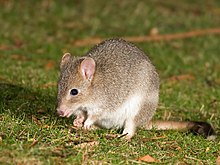
Eastern bettong - Eastern bettong (Bettongia gaimardi)
- Boodie (Bettongia lesueur)
- Woylie (Bettongia penicillata)
- Northern bettong (Bettongia tropica)
- Genus Caloprymnus
- †Desert rat-kangaroo (Caloprymnus campestris)
- Genus Potorous
- Gilbert's potoroo (Potorous gilbertii)
- Long-footed potoroo (Potorous longipes)
- †Broad-faced potoroo (Potorous platyops)
- Long-nosed potoroo (Potorous tridactylus)
- Genus Aepyprymnus
- Family Hypsiprymnodontidae
- Genus Hypsiprymnodon
- Musky rat-kangaroo (Hypsiprymnodon moschatus)
- Genus Hypsiprymnodon



